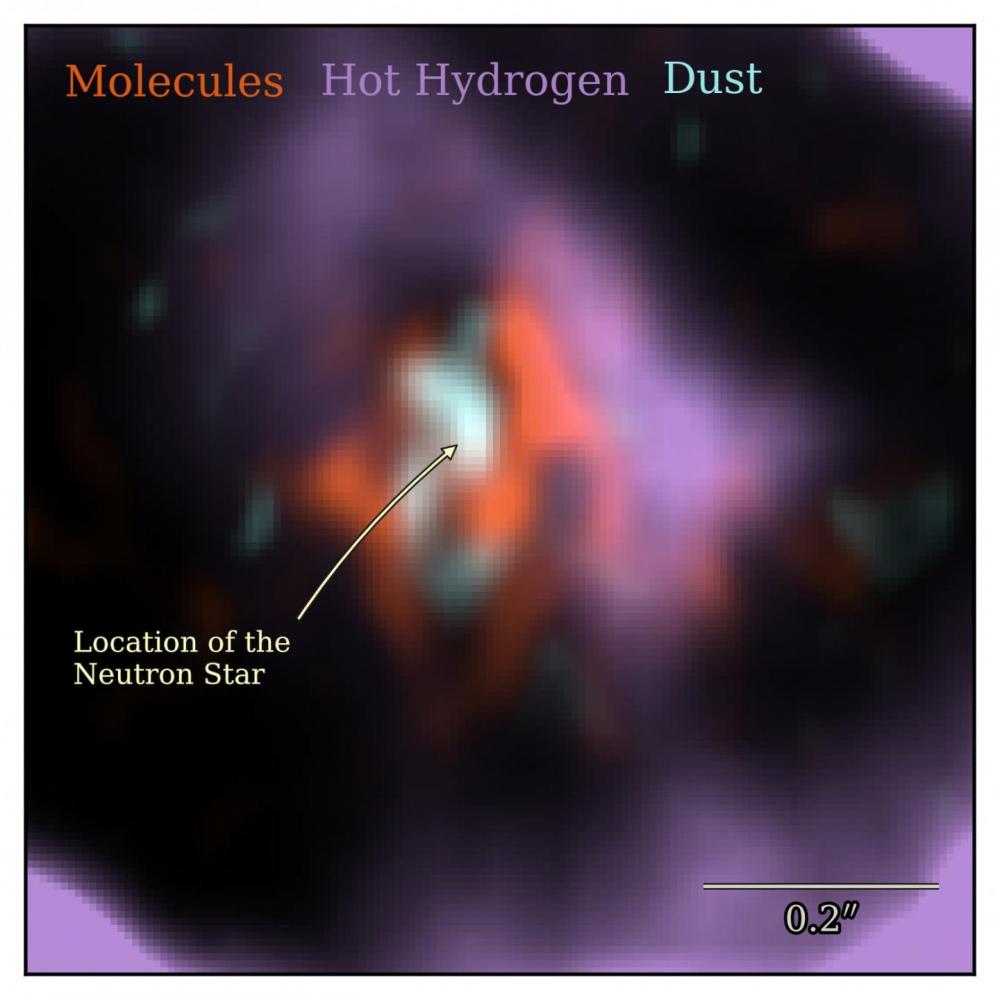An international team, led by astronomers from Cardiff University, with the contribution of the Astrophysics Department of CEA-Irfu, may have spotted for the first time the compact remains of the last star explosion visible by eye that occurred on February 23, 1987 in a nearby galaxy, the Large Magellanic Cloud, only 160 000 light-years away.
Using the high-resolution images of the ALMA radio telescope in the Atacama Desert in northern Chile, the team discovered a small area of dust, warmer than its environment, which may correspond to the supposed location of the compact neutron star that should have formed during the explosion according to theoretical models. This compact object had been searched without success for more than 30 years. This indirect discovery nevertheless requires to be confirmed by additional data. These results are published in The Astrophysical Journal.
On February 23, 1987, a new star (or supernova) appeared in the sky of the southern hemisphere. Its light, that reached Earth at that time, revealed in fact a powerful star explosion whose brightness reached more than 100 million times that of the Sun. It continued to shine for several months. This supernova, which is the only supernova visible to the naked eye, since that discovered by Kepler in 1604, has been named SN 1987A (depending on the year and its order number).
SN 1987A is undoubtedly one of the major astronomical events of the twentieth century. No celestial object has so far been the subject of so much research and publications. One of the major discoveries was the first detection of cosmic neutrinos, considered as an indirect proof of the formation of a compact object, a neutron star, resulting from the collapse of the imploding heart of the star. This rapidly rotating neutron star should manifested itself by a periodic emission, as a pulsar, once the envelope of the supernova dissipated. The other important result was the observation that dust had condensed in the ejecta, some 400 days after the explosion of the supernova. These dusts could thus mask a certain time the expected pulsar. But more than thirty years after the explosion, this pulsar has still not been detected.
The relative proximity of SN 1987A allowed a detailed study of the evolution of ejecta. As part of an international project called "SAINTS" (for SN 1987A Intensive Study) astrophysicists have continued to study its evolution with the Hubble satellite and the large ground-based telescopes (VLT and Gemini), revealing in passing its spectacular morphology similar to a "pearl necklace". SN 1987A was also regularly observed in thermal infrared by an international team led jointly by Patrice Bouchet of the Astrophysics Department of CEA (DAp) and Edward Dwek of NASA Goddard Space Flight Center, allowing the study of different shocks in this extremely hectic environment.
Finally in 2010, the European infrared satellite Herschel, to everyone's surprise, detected in the ejecta a huge reservoir of other very cold dusts, which no one suspected existed. The resolution of the Herschel images was nevertheless insufficient to draw a precise map.
Using the large ALMA (Atacama Large Millimeter / Submillimeter Array) radio interferometer, the researchers were able to conduct a comprehensive and detailed study of the nearby environment of the SN 1987A explosion. Their results show that this environment is extremely heterogeneous: dust packets are close to gas clouds, which are themselves distinct according to their chemical composition. But one detail immediately intrigued astronomers: while the dust as a whole radiates at a temperature of about 20 ° K, at a specific location this temperature increases to 37 ° K.
"Everything happens as if there was a source of hidden energy," explains Patrice Bouchet from the DAp "and this region is approximately near the center of the ejecta, where we would exactly expect the presence of the neutron star, the remnant of the explosion".
The compact core of the star could therefore continue to beat, buried and hidden in its cocoon of dust. But this very slight rise in the temperature of the dust is still a very indirect proof. It could also be due for example to heating by the large amount of radioactive materials - such as Titanium-44 - also produced in the explosion. According to Patrice Bouchet "It is still much too early to say, as it has been done in some press releases, that the hot heart of the 1987A supernova has been discovered and it will probably be necessary to wait a little longer for this dust to dissipate ".
Other hypotheses have also been suggested as the possibility that the neutron star has finally turned into a black hole. The famous superova SN 1987A has still not revealed all its secrets!

A close-up view of the various components of the central part of the SN 1987A ejectas obtained by ALMA: the molecular gas of carbon monoxide is represented in orange, the hot hydrogen gas in violet, and the dust surrounding the neutron star in cyan. The arrow shows the location where the dust is warmer, which may suggest the influence of a compact star. Credits: Credit Cardiff University
Contact : Patrice BOUCHET
Publication :
- « High Angular Resolution ALMA Images of Dust and Molecules in the SN 1987A Ejecta"
Phil Cigan et al., The Astrophysical Journal, 886, p.51, 2019 November 20
See also in ArXiv : https://arxiv.org/abs/1910.02960
See : "Peering in the dusty heat of SN 1987A" (Nature Astronomy Research Community, 5 december 2019)
Content : Jean-Marc Bonnet-Bidaud, Patrice Bouchet
• Structure and evolution of the Universe › High energy cosmic phenomena and astroparticles
• Institute of Research into the Fundamental Laws of the Universe • Department of Astrophysics (DAp) // UMR AIM
• High Energy Cosmic Phenomena
• HERSCHEL
